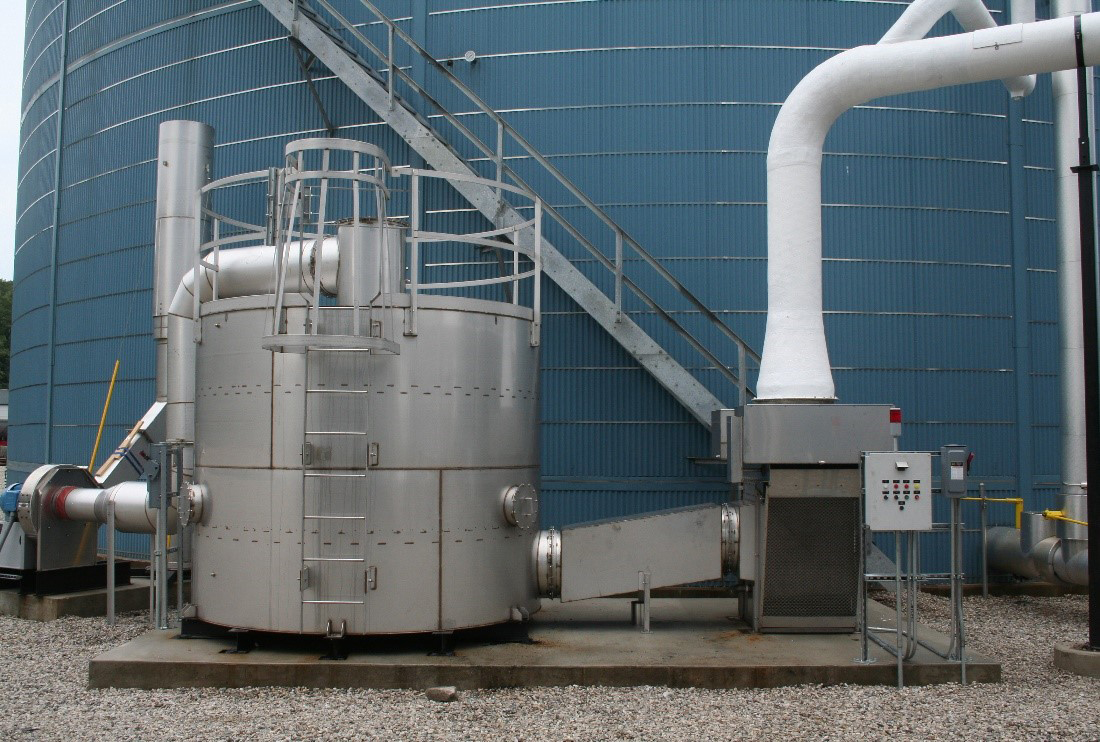
Background
A large asphalt terminal was faced with odor complaints from residential neighbors, elevated hydrogen sulfide (H2S) concentrations on site, and problems with visible emissions.
The terminal included five large asphalt storage tanks in which asphalt was kept at temperatures in the range of 300ºF. The primary source of the odorous emissions was the breather vent in the roof of each tank, through which vapors containing H2S, mercaptans, and VOCs escaped the tanks due to tank breathing and filling. The customer’s corporate engineering group was in need of a system that would remove the H2S and other odorous compounds from the air being discharged from the five tanks.
In addition to the tank emissions problem, there were also emission issues associated with the truck loading rack, where the asphalt was loaded into tank trucks for local distribution. At each loading station, both H2S concentrations and visible emissions were in violation of acceptable regulatory levels. The corporate engineering group therefore also required a solution for the fumes emitted during tank truck loading activities.
Objective
The project had multiple objectives:
Last, the terminal required a system that was proven, reliable, and low maintenance, allowing continuous 24/7 operation with no downtime.
Comparison of Alternatives
The corporate engineering group had three alternatives for proper control of the emissions for each of the applications: (1) APC’s Ultra High-Efficiency Filter (UHF®) unit, for removal of the fine oil mist followed by a CarbonPure activated carbon adsorption system (for removal of H2S and odors); (2) a thermal oxidizer, and (3) a fiber-bed type filter followed by carbon adsorption system.
There were serious reservations around the thermal oxidizer (Option 2) due to the much higher capital cost, significantly higher operating costs (with the air streams being dilute and relatively cold and thus requiring high natural gas costs), and the fire risk associated with oil mist collecting in the system (either on the RTO media or in the heat exchanger in a recuperative system) and catching fire. A high efficiency pre-filter such as the UHF® filter would be needed to remove the oil mist prior to any oxidizer system.
With regard to Option 1, the filter-carbon system was comprised of a UHF® unit followed by a CarbonPure activated carbon adsorption system. The UHF® filter unit is specifically designed for applications with very fine, sticky condensed fumes and particulate such as condensed asphalt fumes. The UHF® unit utilizes dry filter media, presented in roll form, which provides very high removal efficiencies (i.e., 98-99%+) including on submicron particulate. Submicron droplets are agglomerated by the filter into large raindrop-sized droplets that are collected in the bottom tank of the filter unit. The filter does not become plugged and maintains steady air flow by automatically advancing a clean section of filter media into the filtration chamber when the previous filter section becomes caked with particulate. The unit thus operates within a steady differential pressure band (and thus steady air flow rate band) until the entire roll is spent. Filter rolls are changed in a few minutes with no system downtime. From the UHF® unit, the exhaust gas would pass into the CarbonPure vessel containing two activated carbon beds in series for removal of gas-phase H2S and other odorous compounds.
The third option, using a fiber bed type filter in lieu of the UHF® filter, posed serious maintenance concerns. When any solid or semi-solid material is present in the exhaust, as was the case here with asphalt products, the filter blinds and plugs, choking off air flow and allowing fumes to escape to atmosphere. Further, the fiber filter elements are heavy, requiring a crane for change-out, and extremely messy. In contrast, the UHF® unit filters weighed in the range of 50 lbs. (spent) and can easily be handled by one or two people in a few minutes. Lean on staff, the customer selected against the high-maintenance fiber bed filter.
Action and Result
The company had learned of APC’s UHF® system from another large asphalt distributor, who had excellent results with the UHF® system at multiple terminals. So for both applications – the asphalt storage tank vent emissions and the asphalt loading emissions – the proper volumetric air flow rate was identified, the ductwork system designed, and the filter-carbon system comprised of the UHF® filter system followed by the CarbonPure system was installed.
In each application, the UHF® filter unit removes and collects substantial amounts of condensed hydrocarbons (i.e., oil) in its bottom tank, providing important protection for the downstream activated carbon unit. Also in both cases, the elevated H2S concentrations in the area, as well as the aggressive odors, were eliminated. Odor complaints from neighbors ceased, and the council for the local municipality approved the site’s operations once again.
At one point during the slow business period during the first winter, the emission control system was turned off. The asphalt terminal began receiving complaints of odors again, and the emission control system for the tanks was re-started to remove the odors.
The customer is very pleased with the system, noting that all project objectives were met.
Odor removal efficiency was not specifically measured for this project (odor complaints from neighbors being the only metric), but had been measured for a similar project at another customer location. The results are summarized in the following table.
|
Parameter |
Average |
| Date | 08/10/05 |
| Air Temperature during Sampling | 116˚F |
| Odor Detection Threshold: | |
| Inlet (Odor Units) | 1,247 O.U. |
| Outlet (Odor Units) | 4.3 O.U. |
| Odor Removal Efficiency (%) | 99.7% |